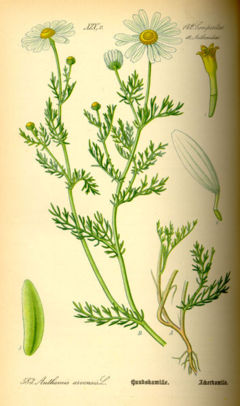Anthemis: Difference between revisions
No edit summary |
No edit summary |
||
| Line 14: | Line 14: | ||
Propagation is by seeds or division of the clumps, usually the latter. | Propagation is by seeds or division of the clumps, usually the latter. | ||
A. Aizoon, Griseb.-Achillea ageratifolia. Gn. 24:342.—A. arabica, Linn.-Cladanthus.—A. coronaria, Hort.-Chrysanthemum coronarium.—A. floribunda, Hort. Dwarf: Lvs. much dissected: fl.-heads pure white. — A. Biebersteiniana, Koch, is found in some catalogues. It is an alpine plant with pinnate Lvs., which are silvery, and yellow fls. Can be cult. only in the alpine garden. | |||
}} | }} | ||
Revision as of 10:34, 18 January 2010
| Anthemis subsp. var. | ||||||||||||||||||||||||||||||||||||||||||||||||||||||||
|---|---|---|---|---|---|---|---|---|---|---|---|---|---|---|---|---|---|---|---|---|---|---|---|---|---|---|---|---|---|---|---|---|---|---|---|---|---|---|---|---|---|---|---|---|---|---|---|---|---|---|---|---|---|---|---|---|

|
|
| ||||||||||||||||||||||||||||||||||||||||||||||||||||||
| ||||||||||||||||||||||||||||||||||||||||||||||||||||||||
| Standard Cyclopedia of Horticulture |
|---|
|
Anthemis (Greek name of the chamomile). Compositae. Chamomile. Pyrethrum-like heavy-scented plants, annual, biennial or perennial, members of a large, Old World temperate-region genus, used in borders and alpine gardens. Heads many-fld., the disk yellow, the rays white and yellow and (in the common cult, species) pistillate, the receptacle conical and chaffy, the achenes terete or ribbed, and either naked or bearing a minute crown: Lvs. pinnately dissected. Two or three of the species are weeds. Others are excellent border plants. The true chamomile is a medicinal plant. The hardy perennial species, which alone are grown in this country, are easily handled in the border, where they bloom from midsummer till frost. They thrive in almost any soil, but need full exposure to sun. Propagation is by seeds or division of the clumps, usually the latter. A. Aizoon, Griseb.-Achillea ageratifolia. Gn. 24:342.—A. arabica, Linn.-Cladanthus.—A. coronaria, Hort.-Chrysanthemum coronarium.—A. floribunda, Hort. Dwarf: Lvs. much dissected: fl.-heads pure white. — A. Biebersteiniana, Koch, is found in some catalogues. It is an alpine plant with pinnate Lvs., which are silvery, and yellow fls. Can be cult. only in the alpine garden.
|
| Anthemis {{{status}}} Fossil range: {{{fossil_range}}}
| ||||||||||||||||||||||||||||||||||||||||||||||||||||||||||||||||||
|---|---|---|---|---|---|---|---|---|---|---|---|---|---|---|---|---|---|---|---|---|---|---|---|---|---|---|---|---|---|---|---|---|---|---|---|---|---|---|---|---|---|---|---|---|---|---|---|---|---|---|---|---|---|---|---|---|---|---|---|---|---|---|---|---|---|---|
 Corn chamomille (Anthemis arvensis) | ||||||||||||||||||||||||||||||||||||||||||||||||||||||||||||||||||
| Plant Info | ||||||||||||||||||||||||||||||||||||||||||||||||||||||||||||||||||
| ||||||||||||||||||||||||||||||||||||||||||||||||||||||||||||||||||
| Scientific classification | ||||||||||||||||||||||||||||||||||||||||||||||||||||||||||||||||||
| ||||||||||||||||||||||||||||||||||||||||||||||||||||||||||||||||||
| [[{{{diversity_link}}}|Diversity]] | ||||||||||||||||||||||||||||||||||||||||||||||||||||||||||||||||||
| {{{diversity}}} | ||||||||||||||||||||||||||||||||||||||||||||||||||||||||||||||||||
| Binomial name | ||||||||||||||||||||||||||||||||||||||||||||||||||||||||||||||||||
| {{{binomial}}} | ||||||||||||||||||||||||||||||||||||||||||||||||||||||||||||||||||
| Trinomial name | ||||||||||||||||||||||||||||||||||||||||||||||||||||||||||||||||||
| {{{trinomial}}} | ||||||||||||||||||||||||||||||||||||||||||||||||||||||||||||||||||
| Type Species | ||||||||||||||||||||||||||||||||||||||||||||||||||||||||||||||||||
| {{{type_species}}} | ||||||||||||||||||||||||||||||||||||||||||||||||||||||||||||||||||
| Species | ||||||||||||||||||||||||||||||||||||||||||||||||||||||||||||||||||
| About 100 species, including: Anthemis cotula | ||||||||||||||||||||||||||||||||||||||||||||||||||||||||||||||||||
| [[Image:{{{range_map}}}|{{{range_map_width}}}|]] | ||||||||||||||||||||||||||||||||||||||||||||||||||||||||||||||||||
| Synonyms | ||||||||||||||||||||||||||||||||||||||||||||||||||||||||||||||||||
| {{{synonyms}}} |
Anthemis (Án-the-mis) is a genus of about 100 species of aromatic herbs in the Asteraceae, closely related to Chamaemelum, and like that genus, known by the common name Chamomile; some species are also called Dog-fennel or Mayweed. However, Mayweed is improperly used for this genus since Mayweed refers to the Matricaria genus. Anthemis are native to the Mediterranean region and southwest Asia east to Iran. They have been grown in and have become native to England/United Kingdom.
Anthemis species are used as food plants by the larvae of some Lepidoptera species including Bucculatrix anthemidella, a leaf-miner which feeds exclusively on Anthemis tinctoria.
Cultivation and uses
The flowers are commonly used for tea, and the leaves, when crushed, give off a scent of apples. It grows well in light, sandy soil. Nicknamed "the plants' physician", it seems to improve the health of other plants grown near it. Chamomile flowers make a good rinse for fair hair.
Species
Anthemis contains about 100 species, including the following:
- Anthemis altissima
- Anthemis arvensis
- Anthemis austriaca
- Anthemis cinerea
- Anthemis cotula
- Anthemis cretica
- Anthemis haussknechtii
- Anthemis macedonica
- Anthemis marschalliana
- Anthemis nobilis (also known as Chamaemelum nobile), Roman chamomile
- Anthemis punctata
- Anthemis rosea
- Anthemis sanci-johannis
- Anthemis secundiramea
- Anthemis styriaca
- Anthemis tinctoria
- Anthemis triumfetti
- Anthemis tuberculata